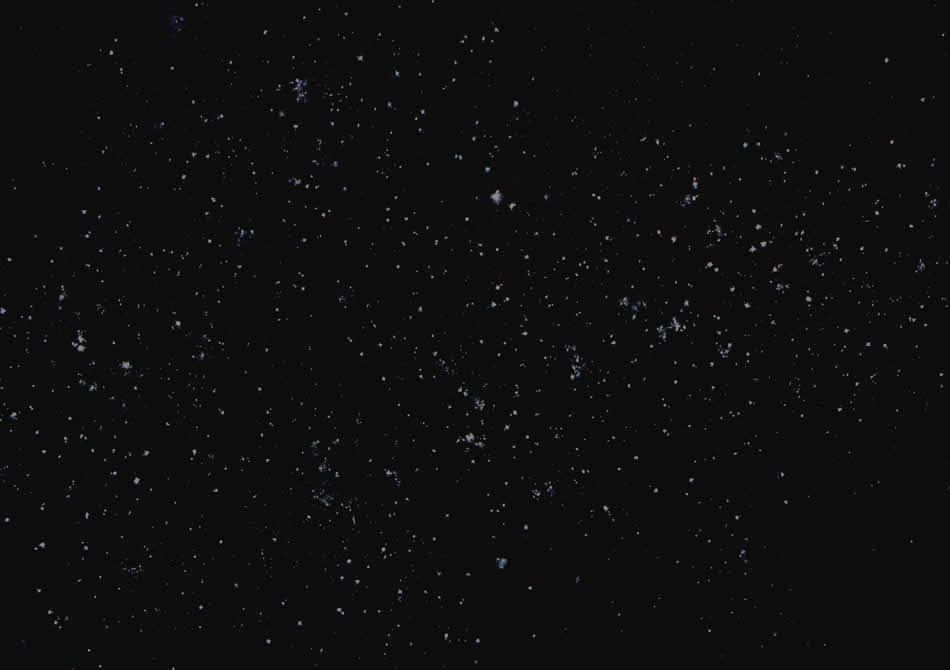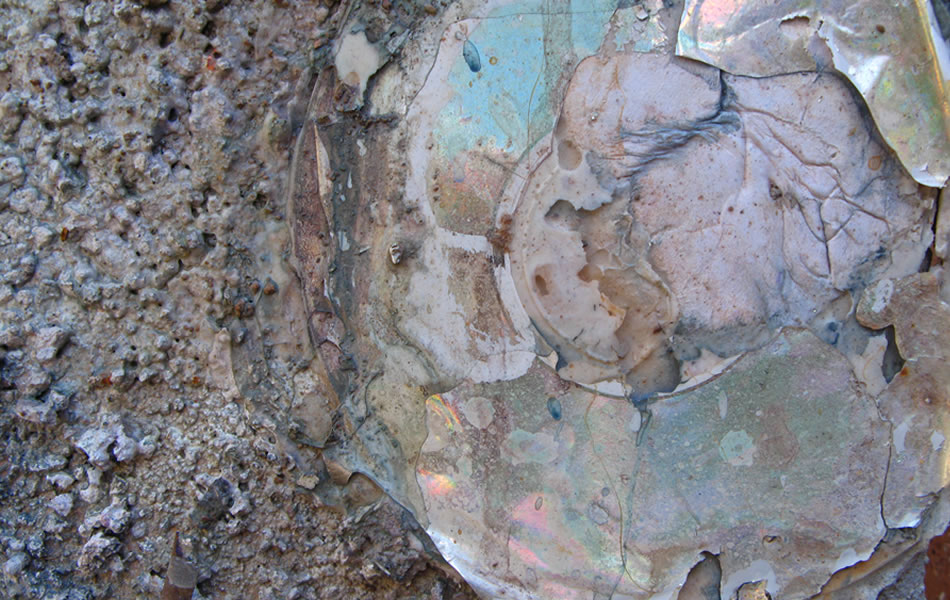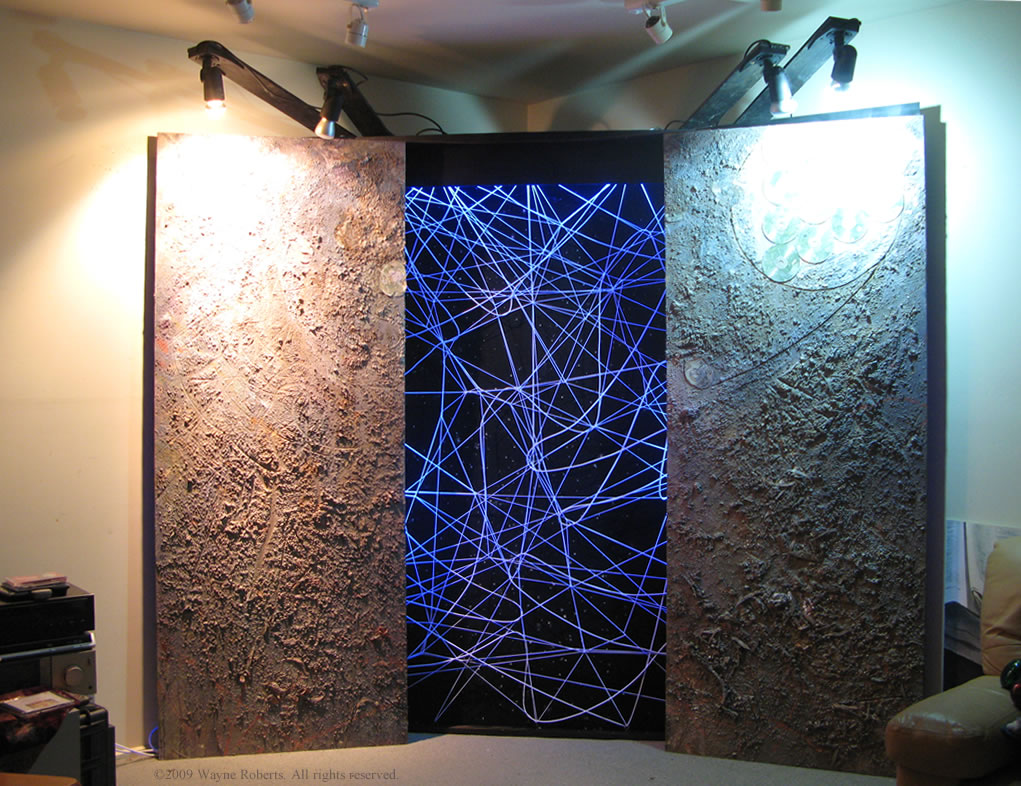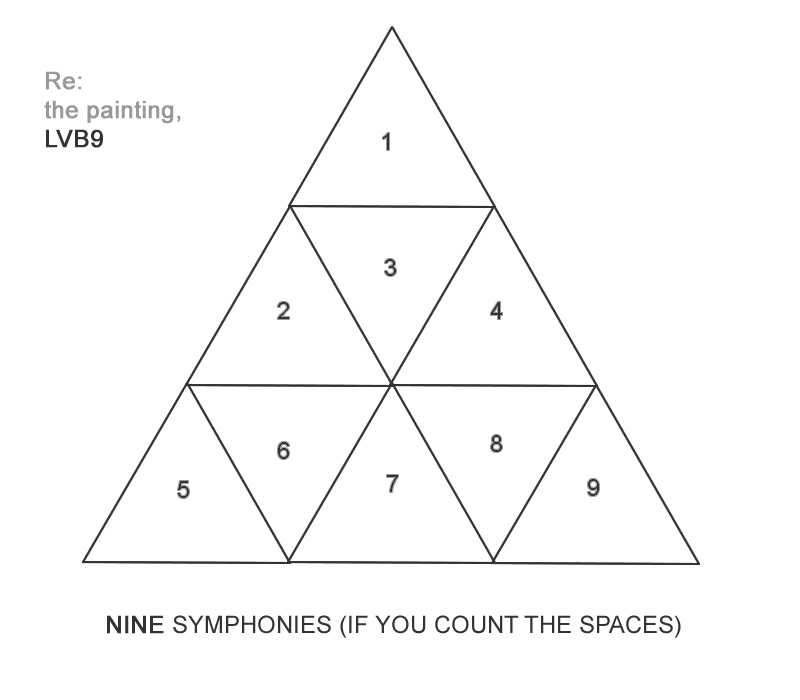inspired by Ludwig van Beethoven's Symphony No 9 (The Ninth)
recent artwork (2009) by Australian artist Wayne Roberts
other works watercolours | essay | awards | poetry | home

LVB9 installation art by Wayne Roberts (c) copyright 2009 Wayne Roberts
| © 2009 Wayne Roberts, 242 cm (w) x 204 cm (h) x 172 cm (d) 3-D work on two doors, black woollen stretched textile. Two Doors: Mixed media: CD-collage, oxides, detritus, mixed aqueous paints, acrylic media, water, inks, applied with aged implements. Intaglio lineation. Black woollen textile on stretcher frame with titanium, internal black lighting. 10 CDs in triangular formation (top right). This area has embedded stereo-sound-responsive Light Emitting Diodes (LEDs). |

Starfield behind artwork: titanium on black woollen textile on stretcher frame

The 9th symphony of Beethoven is arguably one of the greatest symphonies ever written. The 9th was without doubt a pivotal work. A landmark piece in the history of music. Many composers who followed were inspired or influenced by it. It was even influential in determining the diameter of CDs at 12cm in the early 1980s. (At that time, it was decided that a CD should be able to fit an entire performance of Beethoven's 9th on a single CD. The longest recording of Beethoven's 9th was found (an old mono, approx 78mins), and that became the benchmark, hence 12cm. [The story has some interesting twists and turns, but that's the gist of it.] The earlier movements, often with passages of agitation, seem to reflect his battle against the deafness that had gradually and relentlessly overtaken him. The last movement is in stark contrast to the earlier ones. In the final movement, he ever so serenely introduces the main theme of the final movement, via an unornamented beautiful melody, on strings and subdued orchestra. This theme builds rather steeply (and dramatically) to usher in the finale, including parts for four vocal soloists, and large choir. (It is the first symphony to employ the human voice as a virtual instrument.) Beethoven couldn't conduct the premiere of his Symphony No 9 (May 7, 1824) due to his profound deafness. Yet he was by the conductor's side following the score, and reportedly quite animated. Story has it that he was a couple of bars behind when the work ended to rapturous applause and ovations. The deaf Beethoven had to be physically turned around by one of the vocal soloists so that he could "see" the applause. He received fully five standing ovations (which was considered disrespectful of the royals, because only royalty were deemed worthy enough of receiving up to a maximum of three ovations.) Beethoven eventually left the hall after the tumultuous reception, and was reportedly deeply overcome with emotion. Ludwig van Beethoven died during a thunderstorm on 26 March 1827. "His friend Anselm Hüttenbrenner, who was present at the time, claimed that there was a peal of thunder at the moment of death" (Wikipedia). |

LVB9 CD circle-triangle region (close-up view)

LVB9 CD circle-triangle region (2nd close-up view)

LVB9 CD circle-triangle region (3rd close-up view)

LVB9 with night lighting, 2
 |
 |
After Beethoven's Ninth, The number nine unnerves several composers... Beethoven's Ninth symphony was so influential upon many later composers that some even feared nearing their own ninth symphonies. The ninth was, after all, Beethoven's final symphony and final major work. Moreover, several other composers had also only reached nine symphonies. This led to an apprehension amongst some composers when their own symphony tally approached nine. Some even purposely stopped before getting there. The concept of the (allegedly) "square number" 9 relates directly to my theory work in PON (Principles of Nature). In this painting (and in consideration of the above-mentioned fear of some composers) I had the idea of jumping the hurdle and visually showing a literal 'equivalence' between 9 and 10. It sounds crazy, right? Like the idea that the Earth goes around the Sun. Not everything that seems illogical (at first sight) is necessarily so. 'Counting' is not restricted to one method. I show a simple example here in this painting of two consistent ways of counting using the same symmetrical form: an equilateral triangle of side length 3x3 to demonstrate, in effect, that 9 can 'equal'10. One of the problems in current mathematics and physic etc, in my view, has been a rather strict adherence to a 'number-counting orthodoxy'. It's perhaps for this reason that some of the equations in the sciences have become incredibly complex, even ugly. If 'resonant units' (forms of numbers) were found that were 'attuned' to the subject under consideration, then I have little doubt that the equations would be simpler, more harmonious, more 'musical'. I discuss this at length, together with the presentation of two new Pythagoras-like theorems I discovered, in my book Principles of Nature: towards a new visual language. An abridged version I've also published to the web principlesofnature.com The upper left diagram shows that if you count the internal self-similar spaces you get 9. The right-hand diagram shows that by counting the node-points you get 10. (In the painting I positioned the CDs at the node points creating a triangular grid of 10 CDs) Yet there remains the (now more covert) grid of 'in-between' spaces (3X3 i.e. 9 equilateral triangles). This creates a 9↔10 resonance or a '9↔10 equivalence principle'. That numerical equivalence is integral to an interpretation of the painting. Beethoven's 9th was a portal in the history of music. And to this day it seems able to open the mind. Yet I've observed that some seem dismissive of works like Beethoven's 9th (for whatever reason). For them, the lack of seeing value in the work is perhaps not unlike being asked to step outside from a brightly-lit room at night. They see nothing but darkness and hurry back inside. However a few linger. And after a time, wide-eyed, the inner eye (the pupil) also opens. Then they see the myriad stars, the Milky Way arcing overhead. The stellata meravigliosa. Similarly, Beethoven's music, his 9th, will fall on deaf ears for those whose 'inner eye' is closed, who remain unmoved by the aged and deaf Ludwig van Beethoven, and who are sadly incapable of imagining his silent imagination. |
An interesting synchronicity
This visual artwork, inspired by Beethoven, was finished only a few months before
the announcement of a major film on Beethoven: In Search of Beethoven! is
to be released in Cinemas soon (November, 09). The movie has received considerable
pre-release critical acclaim. To me, as the artist of this visual piece, I find it very curious (in fact amazing)—such a synchronicity.
home
all images © copyright 2009 W Roberts. All rights reserved.
Principles of Nature (separate theory site by W Roberts)
Email feedback: info@wroberts.com.au or, simply click this email quicklink to info @ wroberts . com .au Home | brief essay on 'style' in art | awards | poetry | watercolours
All paintings © copyright 1985-2008 Wayne Roberts. All rights reserved.
